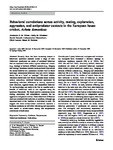Behavioral correlations across activity, mating, exploration, aggression, and antipredator contexts in the European house cricket, Acheta domesticus
| dc.contributor.author | Wilson, Alexander | |
| dc.contributor.author | Whattam, EM | |
| dc.contributor.author | Bennett, R | |
| dc.contributor.author | Visanuvimol, L | |
| dc.contributor.author | Lauzon, C | |
| dc.contributor.author | Bertram, SM | |
| dc.date.accessioned | 2018-05-09T10:32:13Z | |
| dc.date.available | 2018-05-09T10:32:13Z | |
| dc.date.issued | 2010-04 | |
| dc.identifier.issn | 0340-5443 | |
| dc.identifier.issn | 1432-0762 | |
| dc.identifier.uri | http://hdl.handle.net/10026.1/11461 | |
| dc.description.abstract |
Recently, there has been increasing interest in behavioral syndrome research across a range of taxa. Behavioral syndromes are suites of correlated behaviors that are expressed either within a given behavioral context (e. g., mating) or between different contexts (e. g., foraging and mating). Syndrome research holds profound implications for animal behavior as it promotes a holistic view in which seemingly autonomous behaviors may not evolve independently, but as a "suite" or "package." We tested whether laboratory-reared male and female European house crickets, Acheta domesticus, exhibited behavioral syndromes by quantifying individual differences in activity, exploration, mate attraction, aggressiveness, and antipredator behavior. To our knowledge, our study is the first to consider such a breadth of behavioral traits in one organism using the syndrome framework. We found positive correlations across mating, exploratory, and antipredatory contexts, but not aggression and general activity. These behavioral differences were not correlated with body size or condition, although age explained some of the variation in motivation to mate. We suggest that these across-context correlations represent a boldness syndrome as individual risk-taking and exploration was central to across-context mating and antipredation correlations in both sexes. © Springer-Verlag 2009. | |
| dc.format.extent | 703-715 | |
| dc.language | en | |
| dc.language.iso | en | |
| dc.publisher | Springer Science and Business Media LLC | |
| dc.subject | Personality | |
| dc.subject | Boldness | |
| dc.subject | Temperament | |
| dc.subject | Behavioral syndromes | |
| dc.subject | Risk-taking | |
| dc.title | Behavioral correlations across activity, mating, exploration, aggression, and antipredator contexts in the European house cricket, Acheta domesticus | |
| dc.type | journal-article | |
| dc.type | Journal Article | |
| plymouth.author-url | https://www.webofscience.com/api/gateway?GWVersion=2&SrcApp=PARTNER_APP&SrcAuth=LinksAMR&KeyUT=WOS:000275631100001&DestLinkType=FullRecord&DestApp=ALL_WOS&UsrCustomerID=11bb513d99f797142bcfeffcc58ea008 | |
| plymouth.issue | 5 | |
| plymouth.volume | 64 | |
| plymouth.publication-status | Published | |
| plymouth.journal | Behavioral Ecology and Sociobiology | |
| dc.identifier.doi | 10.1007/s00265-009-0888-1 | |
| plymouth.organisational-group | /Plymouth | |
| plymouth.organisational-group | /Plymouth/Faculty of Science and Engineering | |
| plymouth.organisational-group | /Plymouth/Faculty of Science and Engineering/School of Biological and Marine Sciences | |
| plymouth.organisational-group | /Plymouth/REF 2021 Researchers by UoA | |
| plymouth.organisational-group | /Plymouth/REF 2021 Researchers by UoA/UoA07 Earth Systems and Environmental Sciences | |
| plymouth.organisational-group | /Plymouth/Users by role | |
| plymouth.organisational-group | /Plymouth/Users by role/Academics | |
| dc.identifier.eissn | 1432-0762 | |
| dc.rights.embargoperiod | Not known | |
| rioxxterms.versionofrecord | 10.1007/s00265-009-0888-1 | |
| rioxxterms.licenseref.uri | http://www.rioxx.net/licenses/all-rights-reserved | |
| rioxxterms.type | Journal Article/Review |


